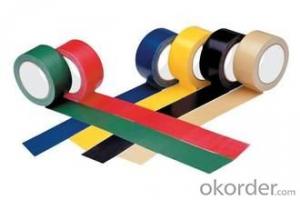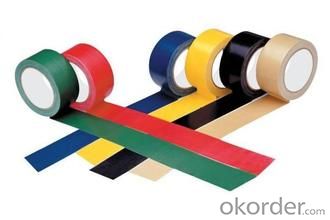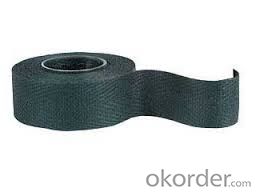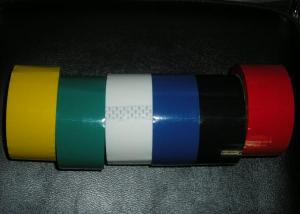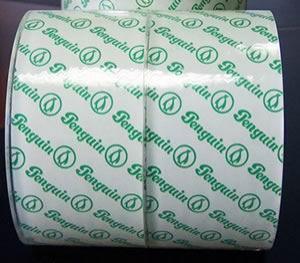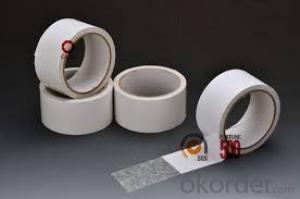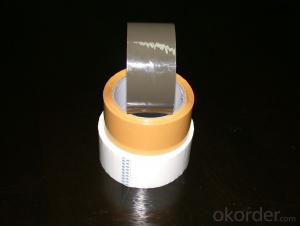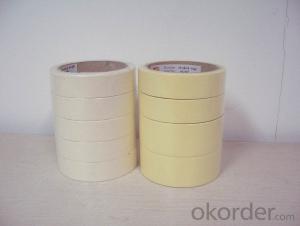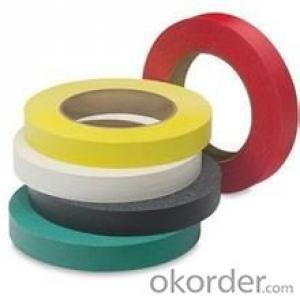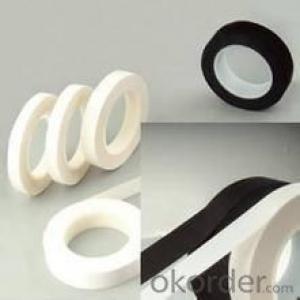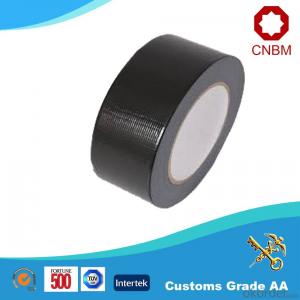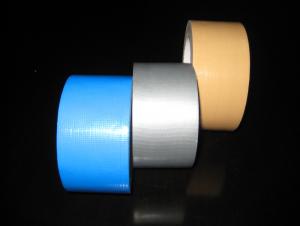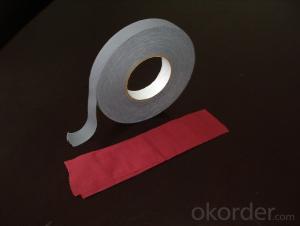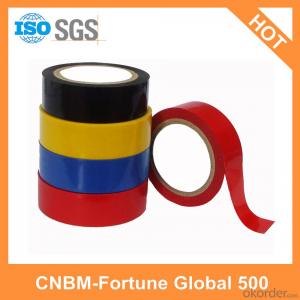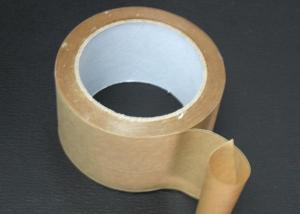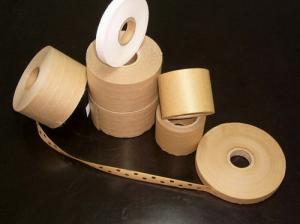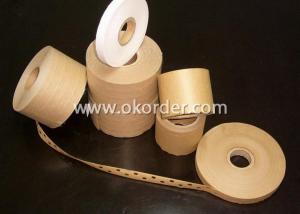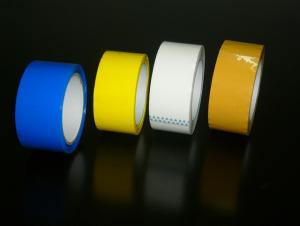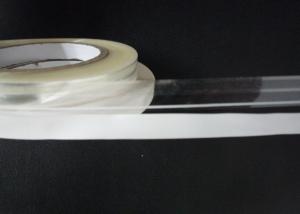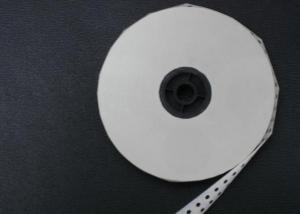3M Packaging Tape Coupon Cloth Tape Hot Melt Mesh35 China’s Top Brand
- Loading Port:
- China main port
- Payment Terms:
- TT OR LC
- Min Order Qty:
- 50 roll
- Supply Capability:
- 600 roll/month
OKorder Service Pledge
OKorder Financial Service
You Might Also Like
Specifications
·World Top 500 Enterprises
·Resistance to cold, heat and aging
·Best quality and competitive price
·SGS&ISO9001
Typical Physical Reports of Masking Tape
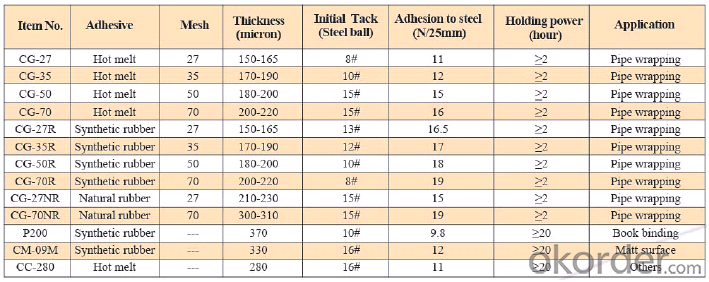
Description
The Cloth Tape is of polyethylene cloth as the carrier, coating with hot melt adhesive, synthetic rubber adhesive or nature rubber. It is excellent in flame retardant, high temperature stability, and anti-aging. It provides well insulation to various products.
The thickness of the tape can be customized.
Application
General purpose of Cloth Tape: widely used for pipe wrapping, gaffers and book binding etc.
Packaging & Delivery
Packaging Detail:
Log Roll: Length 1000mm; width 1060mm.
Cut Roll: As per customer’s requirements
Delivery Detail: within 10-12 working days after receiving your deposit
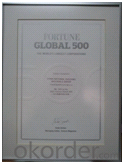
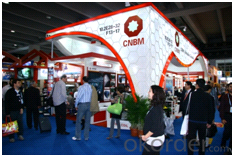
About us
CNBM International Corporation (CNBM International) is a state-owned company and we have sound business relations with clients from over 120 countries. Currently, we have wholly-owned overseas subsidiaries and branches in 5 countries with a view to realize localization, which also represents an essential progress in our globalization target. We have over twenty years experiences.
Welcome to contact us and visit the factory!
- Q: Can packaging tape be used for sealing plastic tubing?
- Packaging tape has the capability to seal plastic tubing. Its design ensures a robust and reliable seal on different surfaces, including plastic materials. Nonetheless, it is crucial to take into account the particular purpose and demands of the plastic tubing. In instances where the tubing is intended for containing pressurized liquids or gases, or if it necessitates a long-lasting and resilient seal, specialized techniques like heat sealing or specific adhesives formulated for plastic materials might be more suitable. Ultimately, the appropriateness of packaging tape for sealing plastic tubing relies on the specific situation and requirements of the application.
- Q: Are there any eco-friendly options for packaging tape?
- Yes, there are eco-friendly options for packaging tape available in the market today. Traditional packaging tapes are typically made from plastic materials such as polypropylene or PVC, which are not biodegradable and have a negative impact on the environment. However, eco-friendly alternatives have been developed to address this issue. Some options include: 1. Paper-based packaging tape: These tapes are made from renewable resources such as paper and natural adhesives. They are biodegradable, compostable, and recyclable, making them a sustainable choice for packaging needs. 2. Water-activated tape: Also known as gummed paper tape, this type of tape is made from paper and requires water to activate the adhesive. It forms a strong bond when applied to boxes and is tamper-evident. Water-activated tape is biodegradable and can be recycled along with the packaging it is applied to. 3. Biodegradable and compostable tape: These tapes are made from plant-based materials such as cellulose or PLA (polylactic acid). They are designed to break down naturally over time, reducing their impact on the environment. Some options are certified as compostable, meaning they can be added to compost piles or sent to composting facilities. 4. Recycled plastic tape: While traditional plastic tapes are not eco-friendly, there are recycled plastic tape options available in the market. These tapes are made from recycled plastic materials, reducing the demand for virgin plastic and promoting a circular economy. When looking for eco-friendly packaging tape, it is important to consider certifications such as the Forest Stewardship Council (FSC) for paper-based tapes or the Biodegradable Products Institute (BPI) certification for compostable tapes. By choosing these alternatives, individuals and businesses can minimize their environmental footprint and contribute to a more sustainable future.
- Q: What are the benefits of using colored packaging tape?
- There are several benefits of using colored packaging tape. Firstly, colored packaging tape allows for easy identification and organization of different items or packages. By using different colors for specific products or categories, it becomes much simpler to quickly locate and retrieve the desired items. This can be especially helpful in warehouses or storage facilities with a large volume of goods. Secondly, colored packaging tape can act as a visual indicator or warning. It can be used to highlight fragile or delicate items, ensuring that they are handled with care during shipping or transport. This can help prevent damage and reduce the risk of mishandling. Additionally, colored packaging tape can be used for branding purposes. By using tape in company colors or with a custom design, businesses can enhance their brand visibility and recognition. This can make their packages stand out amongst others and leave a lasting impression on customers. Furthermore, colored packaging tape can also serve as a security measure. Some tapes are tamper-evident, meaning that it leaves a visible mark or shows signs of tampering if someone tries to open the package. This can help protect the contents of the package and provide reassurance to both senders and recipients. Lastly, colored packaging tape can simply add a touch of aesthetics to the packaging. With a wide range of colors and designs available, businesses can choose tape that complements their branding or adds a pop of color to their packaging, making it more visually appealing. In summary, the benefits of using colored packaging tape include easy identification and organization, visual indicators for fragile items, branding opportunities, security measures, and aesthetic enhancements.
- Q: Does packaging tape have a specific adhesive strength?
- Yes, packaging tape typically has a specific adhesive strength which is designed to securely seal boxes and packages. The adhesive strength can vary depending on the brand and type of packaging tape being used.
- Q: How do you choose the right packaging tape for your needs?
- When choosing the right packaging tape for your needs, it is important to consider a few key factors. First, assess the weight and durability of the items you will be packaging to determine the necessary strength of the tape. Additionally, consider the type of surface you will be sealing, as some tapes adhere better to certain materials. Furthermore, think about the environment in which your packages will be stored or shipped, as temperature and humidity can affect tape performance. Lastly, consider any special requirements you may have, such as tamper-evident or easy-to-tear tape. By considering these factors, you can select the most suitable packaging tape for your specific needs.
- Q: Can packaging tape be used for sealing medical or pharmaceutical supplies?
- Sealing medical or pharmaceutical supplies with packaging tape is not recommended. These supplies require a higher level of sterility and protection from contamination, which packaging tape may not provide. Instead, specialized medical-grade packaging materials like medical adhesive tapes, tamper-evident seals, or sterile packaging are typically used. These materials are designed specifically for the healthcare industry's stringent requirements, ensuring the supplies' integrity and safety. Using packaging tape for sealing medical or pharmaceutical supplies can compromise their sterility and increase the risk of contamination, which could have serious consequences for patients' health. It is crucial to adhere to industry standards and guidelines for packaging and sealing these supplies to maintain their quality and safety.
- Q: Can packaging tape be used for sealing glass bottles?
- Indeed, glass bottles can be sealed using packaging tape. Nevertheless, it is crucial to acknowledge that packaging tape is not explicitly crafted for the purpose of sealing glass bottles; hence, it may not offer the equivalent level of robustness and air-tightness as dedicated bottle sealing techniques. Moreover, the adhesive on packaging tape may fail to adhere effectively to glass surfaces, potentially resulting in leakage or breakage. To guarantee optimal outcomes, it is advisable to employ appropriate bottle sealing methods like cork stoppers, screw caps, or specialized bottle sealing tapes specifically designed for glass bottles.
- Q: What are the considerations for using packaging tape on plastic or polyethylene bags?
- There are several factors to consider when using packaging tape on plastic or polyethylene bags. To begin with, it is crucial to choose the appropriate type of packaging tape for these surfaces. Certain tapes may not adhere well to plastic or polyethylene, resulting in poor adhesion and easy peeling. It is advisable to opt for tapes specifically designed for these materials, as they are typically formulated with adhesive that adheres properly. Another factor to take into account is the tape's strength and durability. Plastic bags are often lightweight and flexible, so it is important to select a tape that can provide sufficient strength to secure the bag's contents. Look for tapes with a strong adhesive backing that are resistant to tearing or stretching. Consideration should also be given to temperature and environmental conditions. Extreme temperatures can impact the tape's adhesive properties, leading to decreased adhesion or brittleness. If the bags will be exposed to high or low temperatures, it is recommended to choose a tape specifically designed for those conditions. Furthermore, it is essential to ensure that the tape does not cause any damage to the plastic or polyethylene bags. Some tapes may have strong adhesives that leave residue or cause harm when removed. Look for tapes labeled as having low residue, easy removal, or being safe for use on these surfaces. Lastly, aesthetics and presentation should be considered. Packaging tape is available in various colors and designs, allowing you to choose a tape that complements the bag's appearance or branding. It is important to make sure that the tape does not obstruct any important information or barcodes on the bag. In conclusion, when using packaging tape on plastic or polyethylene bags, it is important to consider selecting the right tape, ensuring strength and durability, taking into account temperature and environmental conditions, preventing damage to the bags, and considering aesthetics and presentation.
- Q: Can packaging tape be used for sealing envelopes?
- Indeed, sealing envelopes can be accomplished with packaging tape. While its primary purpose is to securely seal boxes and packages, packaging tape can also effectively seal envelopes. Its formidable adhesive properties guarantee a sealed envelope throughout its journey. Nonetheless, it is worth mentioning that packaging tape may not be the most visually appealing option for sealing envelopes, as it tends to be wider and less transparent compared to conventional choices like glue sticks or clear tape.
- Q: What are the common color options for packaging tape?
- Packaging tape manufacturers and the intended use influence the range of color options available. Nevertheless, clear, brown, white, and tan are among the most frequently found colors. Clear tape is transparent, allowing visibility of package contents. Brown or tan tape, often referred to as brown tape, is widely chosen for its strong and secure sealing capabilities. White tape is commonly used for labeling, as it enables easy writing or printing of information. Additionally, packaging tape comes in various other colors, such as red, blue, green, and yellow, which can serve purposes like color-coding or enhancing visual appeal. Ultimately, the choice of packaging tape color is determined by personal preference, branding requirements, or specific organizational needs.
Send your message to us
3M Packaging Tape Coupon Cloth Tape Hot Melt Mesh35 China’s Top Brand
- Loading Port:
- China main port
- Payment Terms:
- TT OR LC
- Min Order Qty:
- 50 roll
- Supply Capability:
- 600 roll/month
OKorder Service Pledge
OKorder Financial Service
Similar products
Hot products
Hot Searches
